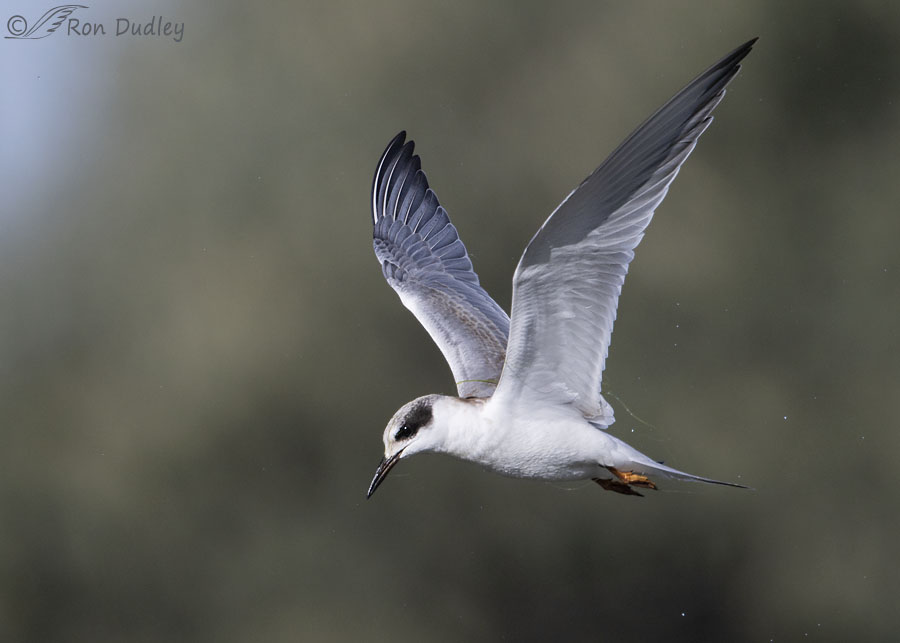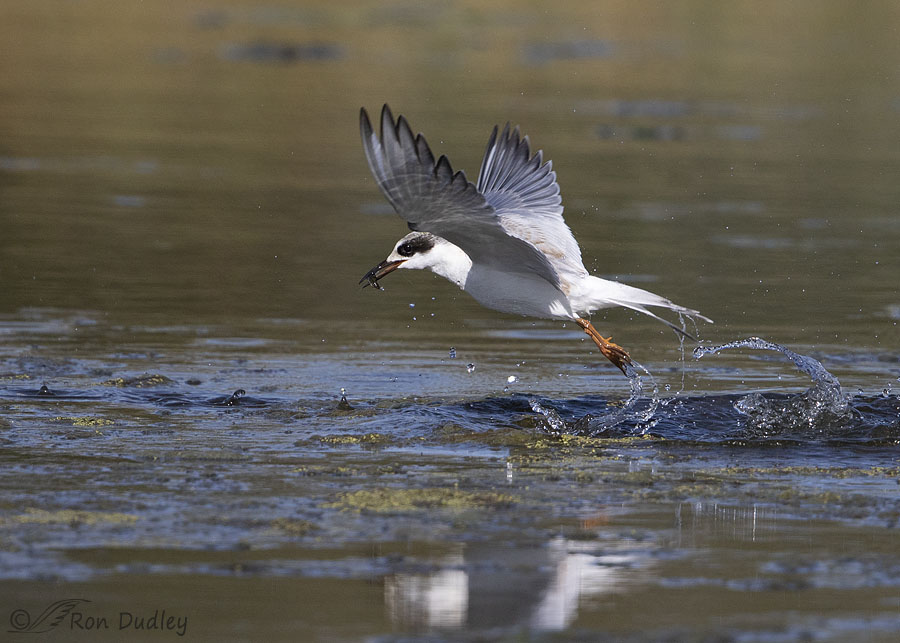It’s been two years since I’ve posted images of this species but yesterday morning at Farmington Bay WMA I had some luck with them (yes, the gate to the 4-way at Farmington is now open after many months of being closed for breeding season.)

1/4000, f/6.3, ISO 500, Canon 7D Mark II, Canon EF 500mm f/4L IS II USM + EF 1.4 III Extender, not baited, set up or called in
After a frustrating and largely birdless morning I found several Forster’s Terns fishing on a pond only minutes before I headed for home. I caught this one in an appealing flight posture against a background I really like. I have a good exposure on the difficult whites in direct sunlight and I succeeded in one of the primary challenges with this species in flight – getting a catch light in the eye. With that photon-sucking black eye set against black feathers it often isn’t easy to do.
There are water droplets coming off the bird which is still wet after an earlier dive and there’s a bit of filamentous material trailing behind the base of the left wing.
But as usual I have a nit to pick. In a perfect world this bird’s head would be slightly sharper – it’s just a little shy of tack sharp. But I still like the image, a lot.

1/4000, f/6.3, ISO 500, Canon 7D Mark II, Canon EF 500mm f/4L IS II USM + EF 1.4 III Extender, not baited, set up or called in
Not long after the previous photo was taken I caught this tern emerging from the water with a small fish. It may or may not be the same bird in both photos.
One thing I really like about the photo is the water column flung backwards by the feet as the bird pushed off from the water. A lot of energy is expended to get them airborne again. This shot would be a little more dramatic if the fish were larger but according to studies a 4″ fish is about maximum size for this species to capture and this one looks to be about half that size.
Other studies have shown that only about 24% of Forster’s Tern dives on fish are successful so I’m happy for both the bird and the photographer it had a fish of any size.
Ron


I’ve been revisiting these photos all day. Love terns. Love the photos. Wish my catch rate was as good as a Tern’s when I go diving for fish:)
Love the water drops and splashes!
Thanks, Jane.
The curls the water and droplets are making are gracefully beautiful to me.
This darn nits! They’re such peaky critters! Amazing that you can see all those little boogers, too. LOL!
You really are far too critical.
What can I say. I yam what I yam…
What a gorgeous bird (or birds)! The flight postures are fabulous! I really like the water play off the feet and tail in the second shot. Glad he got a snack.
P.S. You’re too picky — these are awesome shots.
Thanks, Marty. I said I like it but no photo is perfect…
I suspect that this is yet another often ignored ‘common’ birds – and am so grateful you didn’t. And that your shots met (or almost met) your exaustive standards.
Thank you.
You’re right about them being ignored to some extent, EC. Lots of folks think of them as gulls.
Ron,
Thanks. I didn’t think FB was open for another week or so. I’ll get out there soon!
Stephen
Steven, it always opens the Thursday before the Youth Hunt which is on Saturday.
Ron, could you take a look at an enlargement of the first photo and tell me if you see filament around the bird’s wings near the body and under it’s belly? When you mentioned it in your post I had to take a closer look, but i’ve only got a magnifying glass up against my computer screen. I’m wondering if it’s fishing line, or some kind of aquatic flora.
And once again, thank you for your dedicated work. My world is enlarged every day by looking at what you post.
I checked, Nina. I’m quite sure it’s just natural filamentous material. It’s actually green.
Wow! Wow! Great photos.
Thanks, Nancy.
Beautiful captures. I love watching terns catch fish. They are amazingly fast, so congrats to you for getting some great photos!
I appreciate that, Thanks, Joanne.
Great photos Ron. Getting the catch eye with that black stripe reminds me of the Loggerhead Shrike and how hard it is to get their catch eye. I don’t believe I have ever seen a Forster’s Tern here. In fact I am sure I have not. That is indeed a neat and challenging photo to get them coming up from the water with a catch. Not easily done. I have a photo of just water thrust back from a group of Goldeneyes who took off a microsecond before my reaction.
Ha, I have my share of photos like that, Everett. Thanks.
Both are fantastic shots! I especially like the dark moody background for the tern in the first…it really accentuates the wing feathers beautifully…and the catch light just pops. Your second is all action! Wonderful. I can just imagine how many ‘clicks; you made with these ‘models’! Beautiful.
The background in that shot makes a huge positive difference for me too, Kathy.
Actually there weren’t that many “clicks”. I didn’t have a lot of time with these birds – got lucky on this one I guess.
The water shot is great. I do get a sense of the energy expended.
Thanks, Arwen.
Great pics! I couldn’t open yesterday’s post.
Thanks, Cindy. Can you open it today? If not try rebooting and/or clearing your cache. It’s still working for me and others haven’t reported the problem.
Neat! The 2nd photo IS very dramatic freezing the bird/water/droplets! I’m unfamiliar with the species tho it appears that’s probably to do with not “paying attention” since, if nothing else, they appear to pass through here in N Central MT…..
The 2nd photo IS very dramatic freezing the bird/water/droplets! I’m unfamiliar with the species tho it appears that’s probably to do with not “paying attention” since, if nothing else, they appear to pass through here in N Central MT….. 
Thanks, Judy. Yeah, I think their range includes your area – at least during migration.
Beautiful shots! I love the dark water and background. And I know these birds are pretty tough to track once they start their dive, so I’m really enjoying your success with the one emerging from the water!
Justine, with this species I often spend more time concentrating on catching their emergence from the water after a dive than I do trying to get flight shots and there’s several reasons for that. I think emergence shots are more dramatic and all the commotion on the water (frothy white splashes and the bird struggling to take flight again) makes it a little easier for our active focus points to lock onto the bird and get sharper shots.
The trick at these long focal lengths is getting the bird in the viewfinder before it’s left the water’s surface. They do it quickly so it takes both practice and luck.